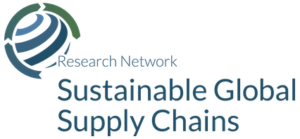How to find synergies between effectiveness and equity when designing supply chain sustainability policies
Janina Grabs, Federico Cammelli, Sam Levy, and Rachael Garrett
Jul, 2024
#Trade and FDI
#Environment and climate change
#Sustainability standards
#Corporate responsibility and lead firms
Companies with global supply chains are under growing pressure to ensure that their activities and sourcing patterns abroad do not contribute to environmental degradation and human rights abuses. In response, many businesses create supply chain sustainability policies. Such company-internal schemes, such as supplier codes of conduct or internal guidelines, specify companies’ commitments and expected supplier practices. These policies are then passed down through multiple tiers of the supply chain until they reach the relevant actors on the factory floor or at the farm level. A prominent example of such policies are zero-deforestation commitments, in which companies pledge to stop purchasing commodities that were grown on former forest land (Garrett et al., 2019). Such zero-deforestation supply chain commitments may contribute significantly to ecosystem conservation.
However, supply chain sustainability policies may also generate unintended outcomes (INOBU, 2016; Klooster, 2005; Pereira et al., 2016). This blog draws on a recently published article (Grabs et al., 2021) to argue that companies can make decisions during supply chain policy design, implementation, and enforcement that allow for synergies between effectiveness (in ecosystem conservation) and equity (in allowing all types of producers to access sustainable supply chains) and avoid trade-offs between the two goals.
Unintended consequences of supply chain sustainability policies? The risk of exclusion
One important example of unintended consequences of supply chain sustainability policies concerns producer exclusion. For instance, such policies may exclude smallholders and other producers with low capacities to adapt to changing supply chain requirements from the value chain. Such unintended exclusion can be prevented by ensuring access equity.
Access equity represents the equal opportunity of different groups of producers, particularly those with high and low adaptive capacities, to participate in sustainable supply chains (Pignataro 2012). Access equity safeguards the freedom of choice of producers to decide which markets they want to participate in. If the sustainable market offers improved prices or sales conditions, they will also be able to benefit from such perks.
But who is likely to be excluded? We suggest to use the concept of adaptive capacity to think about which producers may be inadvertently at a risk of exclusion. Adaptive capacity is any capability or asset that allows producers to rapidly adapt to changing market conditions and expectations. We find that such capabilities can be thought of in six broad categories: education and access to information; technological capacity; financial resources; legal standing; organizational scale and quality; and attitudes, values and norms. In each of these categories, producers with low adaptive capacities may encounter barriers that prevent them from adjusting their practices quickly enough to be kept in the value chain. However, corporate actors may help producers to overcome such barriers, for instance by creating awareness training, simplifying criteria, providing financial support and premium payments, or helping producers to attain necessary legal documents (see Table 1).
However, supply chain sustainability policies may also generate unintended outcomes (INOBU, 2016; Klooster, 2005; Pereira et al., 2016). This blog draws on a recently published article (Grabs et al., 2021) to argue that companies can make decisions during supply chain policy design, implementation, and enforcement that allow for synergies between effectiveness (in ecosystem conservation) and equity (in allowing all types of producers to access sustainable supply chains) and avoid trade-offs between the two goals.
Unintended consequences of supply chain sustainability policies? The risk of exclusion
One important example of unintended consequences of supply chain sustainability policies concerns producer exclusion. For instance, such policies may exclude smallholders and other producers with low capacities to adapt to changing supply chain requirements from the value chain. Such unintended exclusion can be prevented by ensuring access equity.
Access equity represents the equal opportunity of different groups of producers, particularly those with high and low adaptive capacities, to participate in sustainable supply chains (Pignataro 2012). Access equity safeguards the freedom of choice of producers to decide which markets they want to participate in. If the sustainable market offers improved prices or sales conditions, they will also be able to benefit from such perks.
But who is likely to be excluded? We suggest to use the concept of adaptive capacity to think about which producers may be inadvertently at a risk of exclusion. Adaptive capacity is any capability or asset that allows producers to rapidly adapt to changing market conditions and expectations. We find that such capabilities can be thought of in six broad categories: education and access to information; technological capacity; financial resources; legal standing; organizational scale and quality; and attitudes, values and norms. In each of these categories, producers with low adaptive capacities may encounter barriers that prevent them from adjusting their practices quickly enough to be kept in the value chain. However, corporate actors may help producers to overcome such barriers, for instance by creating awareness training, simplifying criteria, providing financial support and premium payments, or helping producers to attain necessary legal documents (see Table 1).
How to generate synergies between effectiveness and equity
In our work, we examine how companies may design supply chain sustainability policies in a way that avoids unintended producer exclusion, while still addressing the sustainability challenges at the center of the policy. As exclusion can pose reputational costs to companies, this can motivate companies to try to tackle this challenge. We find that there are a number of decisions at various points in the policy implementation process that allow for such synergies. Table 2 shows the different stages of the process and seven synergistic steps that companies – in conjunction with other policy makers – can take to ensure producer inclusion without limiting their policies’ effectiveness.
Some companies in key deforestation-risk commodities are already pursuing steps to this effect. For instance, palm oil companies such as Wilmar and Musim Mas have dedicated substantial resources toward widespread rule dissemination and the removal of barriers to compliance (steps 4 and 5). Wilmar’s training program on compliance with the Indonesian Palm Oil Standard reached 8,670 independent smallholders out of 18,100 farmers that directly supply their mills (Wilmar 2020). Lessons learned on scaling outreach efforts – such as train-the-trainer programs – are now also increasingly used to sensitize smallholder farmers on no-deforestation criteria and rules directly. Further, select farmers are aided in getting land titles and other types of legal alignment (step 5), albeit still on a pilot project level.
Cocoa companies, in contrast, support smallholder transformations by piloting community co-production (step 3) and payments for compliance (step 6). The Cocoa and Forests Initiative was launched in 2017 as a highly ambitious, sector-wide, public-private partnership that aimed to tackle the problem of commodity-driven deforestation in a holistic fashion (Carodenuto 2019). In a step-wise, multi-stakeholder approach, actors moved from statements of intent to joint action frameworks and implementation plans, which ensured a strong coordination between public and private actors (step 2). Although cocoa farmers were not strongly involved in policy development, some companies organized consultations in cocoa communities on the implementation of the framework (step 3). Furthermore, positive incentive-setting for conservation (step 6) was also integrated, as companies promoted payments for ecosystem services to protect and restore forested areas. However, such schemes are still at a small scale.
In our work, we examine how companies may design supply chain sustainability policies in a way that avoids unintended producer exclusion, while still addressing the sustainability challenges at the center of the policy. As exclusion can pose reputational costs to companies, this can motivate companies to try to tackle this challenge. We find that there are a number of decisions at various points in the policy implementation process that allow for such synergies. Table 2 shows the different stages of the process and seven synergistic steps that companies – in conjunction with other policy makers – can take to ensure producer inclusion without limiting their policies’ effectiveness.
Some companies in key deforestation-risk commodities are already pursuing steps to this effect. For instance, palm oil companies such as Wilmar and Musim Mas have dedicated substantial resources toward widespread rule dissemination and the removal of barriers to compliance (steps 4 and 5). Wilmar’s training program on compliance with the Indonesian Palm Oil Standard reached 8,670 independent smallholders out of 18,100 farmers that directly supply their mills (Wilmar 2020). Lessons learned on scaling outreach efforts – such as train-the-trainer programs – are now also increasingly used to sensitize smallholder farmers on no-deforestation criteria and rules directly. Further, select farmers are aided in getting land titles and other types of legal alignment (step 5), albeit still on a pilot project level.
Cocoa companies, in contrast, support smallholder transformations by piloting community co-production (step 3) and payments for compliance (step 6). The Cocoa and Forests Initiative was launched in 2017 as a highly ambitious, sector-wide, public-private partnership that aimed to tackle the problem of commodity-driven deforestation in a holistic fashion (Carodenuto 2019). In a step-wise, multi-stakeholder approach, actors moved from statements of intent to joint action frameworks and implementation plans, which ensured a strong coordination between public and private actors (step 2). Although cocoa farmers were not strongly involved in policy development, some companies organized consultations in cocoa communities on the implementation of the framework (step 3). Furthermore, positive incentive-setting for conservation (step 6) was also integrated, as companies promoted payments for ecosystem services to protect and restore forested areas. However, such schemes are still at a small scale.
The way forward
In conclusion, businesses need to be part of global solutions to meet the complex and multidimensional sustainability challenges of our time. However, ad-hoc or naive approaches may cause unintended consequences and have adverse livelihood impacts on the most vulnerable global value chain members. Companies can avoid such drawbacks, and thereby avoid reputational cost, by closely considering the likely effects of sustainable supply chain policies on diverse actors in a businesses’ value chain, and adjusting their rules and support structures in response. In this way, they can generate synergies between the effectiveness and equity of their supply chain sustainability policies. At the same time, companies cannot do it alone – there is an urgent need for greater cooperation and alignment by public policymakers in producing and consuming regions to provide the regulatory space and resources for the steps outlined above (e.g. a clear land tenure system) and to contribute to a more equal playing field (e.g. by providing financial incentives for more inclusive supply chains and disincentivizing smallholder exclusion). In the long run, moving toward more diversified, sustainable economies may be the best bet for tropical countries that aim to pursue sustainable livelihoods and development while preserving vital ecosystems.
In conclusion, businesses need to be part of global solutions to meet the complex and multidimensional sustainability challenges of our time. However, ad-hoc or naive approaches may cause unintended consequences and have adverse livelihood impacts on the most vulnerable global value chain members. Companies can avoid such drawbacks, and thereby avoid reputational cost, by closely considering the likely effects of sustainable supply chain policies on diverse actors in a businesses’ value chain, and adjusting their rules and support structures in response. In this way, they can generate synergies between the effectiveness and equity of their supply chain sustainability policies. At the same time, companies cannot do it alone – there is an urgent need for greater cooperation and alignment by public policymakers in producing and consuming regions to provide the regulatory space and resources for the steps outlined above (e.g. a clear land tenure system) and to contribute to a more equal playing field (e.g. by providing financial incentives for more inclusive supply chains and disincentivizing smallholder exclusion). In the long run, moving toward more diversified, sustainable economies may be the best bet for tropical countries that aim to pursue sustainable livelihoods and development while preserving vital ecosystems.
References
Carodenuto, S. (2019). Governance of zero deforestation cocoa in West Africa: New forms of public–private interaction. Environmental Policy and Governance, 29(1), 55–66.
ETHZ-EPL (2021) Guide for effective and equitable zero-deforestation supply chain policies. Environmental Policy Lab, ETH Zurich.
Garrett, R. D., Levy, S., Carlson, K. M., Gardner, T. A., Godar, J., Clapp, J., et al. (2019). Criteria for effective zero-deforestation commitments. Global Environmental Change, 54, 135–147.
Grabs, J., Cammelli, F., Levy, S. A., & Garrett, R. D. (2021). Designing effective and equitable zero-deforestation supply chain policies. Global Environmental Change, 70, 102357.
INOBU. (2016). A Profile of Small-scale Oil Palm Farmers and The Challenges of Farming Independently. Jakarta: Institut Penelitian Inovasi Bumi.
Klooster, D. (2005). Environmental certification of forests: The evolution of environmental governance in a commodity network. Journal of Rural Studies, 21(4), 403–417.
Pereira, R., Simmons, C. S., & Walker, R. (2016). Smallholders, Agrarian Reform, and Globalization in the Brazilian Amazon: Cattle versus the Environment. Land, 5(3), 24.
Pignataro, G. (2012). Equality of Opportunity: Policy and Measurement Paradigms. Journal of Economic Surveys, 26(5), 800–834.
Wilmar. (2020). Sustainability Report 2019 - Sustainable Sourcing. Wilmar International.
Carodenuto, S. (2019). Governance of zero deforestation cocoa in West Africa: New forms of public–private interaction. Environmental Policy and Governance, 29(1), 55–66.
ETHZ-EPL (2021) Guide for effective and equitable zero-deforestation supply chain policies. Environmental Policy Lab, ETH Zurich.
Garrett, R. D., Levy, S., Carlson, K. M., Gardner, T. A., Godar, J., Clapp, J., et al. (2019). Criteria for effective zero-deforestation commitments. Global Environmental Change, 54, 135–147.
Grabs, J., Cammelli, F., Levy, S. A., & Garrett, R. D. (2021). Designing effective and equitable zero-deforestation supply chain policies. Global Environmental Change, 70, 102357.
INOBU. (2016). A Profile of Small-scale Oil Palm Farmers and The Challenges of Farming Independently. Jakarta: Institut Penelitian Inovasi Bumi.
Klooster, D. (2005). Environmental certification of forests: The evolution of environmental governance in a commodity network. Journal of Rural Studies, 21(4), 403–417.
Pereira, R., Simmons, C. S., & Walker, R. (2016). Smallholders, Agrarian Reform, and Globalization in the Brazilian Amazon: Cattle versus the Environment. Land, 5(3), 24.
Pignataro, G. (2012). Equality of Opportunity: Policy and Measurement Paradigms. Journal of Economic Surveys, 26(5), 800–834.
Wilmar. (2020). Sustainability Report 2019 - Sustainable Sourcing. Wilmar International.
Contact

Janina Grabs
ESADE Business School and Environmental Policy Lab, Department of Humanities, Social and Political Sciences, ETH Zürich


